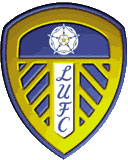 |
 |
 |
Gillies was a dour Scot, born in Kilmichael Glassary, in the Lorn district
of Argyll and Bute, on 15 November 1869. Chesterfield-fc.co.uk: 'The son
of an Argyllshire shepherd, Gillies was born on the shores of Loch Ederline
in 1869. By 1891 he'd been sent to live in Chesterfield with an uncle,
who kept a pub, the Square and Compasses, on West Bars. Gillies had a
sufficiently good education to get work as a compositor for the Derbyshire
Times.' Printer's compositor was the profession he cited in the Census
of 1901. Gillies, sporting a huge moustache and generally to be seen wearing a
sober three piece suit and high collar, was a typical example of his breed
in the early years of the new century, normally referred to as secretary-manager.
The role combined presiding over the club's administration with responsibility
for playing matters, though it meant having to contend with the whims
and fancies of a Selection Committee, comprised chiefly of the club's
directors. After moving down to the East Midlands, Gillies became connected with
the Chesterfield club in 1894, while they were still a junior organisation
playing in the Sheffield League. He was appointed secretary-manager in
the summer of 1895. Formed in 1866, Chesterfield is one of England's oldest clubs, and won
a number of local Cup competitions in the few years before Gillies joined
them. Chesterfield-fc.co.uk: 'The idea of having an individual in charge of
team affairs occurred to the folk of Chesterfield as early as 1871, when
the secretary was invested with "full powers of management"
on match days. This might well be the first such reference to the idea
of management in football history, but Chesterfield Town's earliest secretary-managers
were not professionals; their first Football League spell was very nearly
over before they appointed a "football man", and it would be
the late 1950s, and perhaps even later, before Chesterfield FC trusted
its manager enough to let him pick the team! 'Until 1895 the position of secretary was an honorary one, and it usually
changed every season. The last of Chesterfield Town's honorary secretaries
was its finest; one Edwin Russell Timmeus. Tavistock-born, Timmeus came
to Chesterfield to work as an estate manager for the Duke of Devonshire.
He began playing for the Town club in 1887 but was no great shakes, and
usually served as a stand in goalie. He was a better cricketer, though,
and played for Chesterfield against an All England side that included
W G Grace at the Recreation Ground in 1890. 'Timmeus served around five years as secretary and guided the club through
its first seasons of competitive football in the Sheffield League. His
meticulous approach established a good reputation for the club that enabled
it to make many friends on its way up. As the club grew, though, the demands
that it placed on Timmeus' time proved too great, and he voluntarily stood
aside in favour of Gillies. 'Gillies became the Town club's secretary at the age of 26, in 1895.
Quite how he made the leap to football secretary is a mystery, but the
very fact that he could do probably casts light on the nature of the role
at that time. Like Timmeus, most of Gillies' good work was done off the
field, spreading the Town club's good reputation. 'As secretary-manager, Gillies would have been concerned with the minutiae
of running the club on a day to day basis. There was some involvement
on the playing side; he would have scouted, signed and paid the players,
although board members would usually go to watch a player before signing
him; the board decided who played each week and the trainer usually had
match day responsibility for tactics, especially at away games, which
were not always attended by the secretary-manager. In summary, perhaps,
the secretary-manager might have run things in the way that a modern Director
of Football does.' Gillies supervised Chesterfield's successful application to the Midland
League in 1896 and was a leading light in their battle to earn admission
to the Football League's Second Division during the summer of 1899. Earlier
that year, a limited liability company had been formed to manage the club's
affairs, clearing the existing debts in the process. Gillies, accompanied by Chesterfield vice-president W H Eyre, was in
attendance at the century's final Football League annual general meeting
to plead the Saltergate club's case. He managed to persuade the men who
ran the League to admit the club at the first time of asking. They joined
Middlesbrough as replacements for The club had a successful debut season, finishing 7th out of 18, one
place above Woolwich Arsenal, but slumped to 14th in 1901. Gillies had
used his contacts in his homeland to identify promising Scottish talent
for Chesterfield, but many of them were dismal failures. Despite little
obvious criticism of the job he was doing, Gillies relinquished the reins
of office over the Christmas period of 1900, before his final Scottish
signing, Jimmy Haig, made his debut for the club. Haig would go on to
become a mainstay of Chesterfield for most of the next decade. Gillies' resignation allowed Edmund F Hind to take charge of the club.
The new man was not a success, and presided lamely over a disastrous 1901/02
season. Gillies continued to live and work in Chesterfield and took up refereeing,
reaching a decent standard. He was asked to lend the club a helping hand
in its time of need. According to the Leeds Mercury, 'after an
absence of eighteen months, he returned to their assistance, at the request
of the directors of the club. At this time the organisation was in a very
bad position, being at the bottom of the Second League. He canvassed for
votes on its behalf, and spoke for its re-election at the annual meeting
of the League, and it was largely owing to his efforts that the full number
of votes were polled.' A successful outcome ensured, Gilbert Gillies gave way again, allowing
Jack Hoskin to take over as secretary-manager at Saltergate, although
he continued to attend meetings of the League, now earning his living
as a journalist. The Scot's interest was piqued when the emerging Leeds City club ran
an advertisement for a new manager in the Leeds Mercury on Monday,
13 February, 1905: 'WANTED, energetic and efficient MANAGER. Application,
stating age, qualifications, salary expected, and accompanied by copies
of two testimonials, should be forwarded before the 22nd inst, and marked
"Manager", to J Wilson, Solicitor to the Club, Trinity Chambers,
71 Boar Lane, Leeds.' Gillies was one of more than 100 applicants for the job, but impressed
the City directors with his credentials. On Tuesday, 7 March, the Leeds
Mercury carried the news of his appointment: 'Another step towards the completion of the arrangements for the establishment
of the Leeds City as a club of first-rate standing was made last night,
when the recommendation of the sub-committee for the appointment of a
manager was approved by the General Committee at a meeting held at the
Griffin Hotel, under the presidency of Mr T Furness. There were over a
hundred applicants for the position, and, after reducing the number to
five, the sub-committee decided that Mr G Gillies, of Chesterfield, was
the most suitable candidate. 'He has attended the meetings of the League for the past six years, and
is well appointed with club secretaries, whilst his knowledge of players
and the arrangements to be made for securing admission to the competition
will be of great service to the Leeds Club. 'His testimonials were of the highest character. Amongst those who supported
his application were Mr H S Radford, member of the League Management Committee
and the Football Council; Mr A Kingscott, divisional representative of
the Football Association; Mr A G Hines, hon. Treasurer of the Nottingham
Association; and His status and references persuaded the Leeds City sub-committee to offer
him the post, and he accepted a three-year contract worth £156 per annum. The Football League had decided to increase its membership from 36 to
40 clubs for the 1905/06 season and Leeds City were duly elected, having
come top of the voting with 25 votes. They were accepted into the newly
extended Second Division alongside Chelsea, Hull City, Clapton Orient
and Stockport County, with Doncaster dropping out of the League. In those days much of the responsibility for onfield affairs was left
to trainers, and Gillies was lucky to have alongside him in that role
one George Swift, a former Loughborough left-back who had represented
the Football League in 1895 against the Irish League (and who was to actually
turn out for City once in an emergency). The secretary-manager's normal
sphere of influence was best evidenced in a Yorkshire Post note
of July 1905, which stated, 'Applications for season tickets, which will
be ready in the course of a week or so, should be made to the Club secretary,
Mr G Gillies, of 28, Cross Flatts Place, Beeston, Leeds, up to 10 August
10.' Working in tandem with Swift, Gillies assembled a squad for the new season
in double quick time by pulling together players from the length and breadth
of the country. Seeking to secure a suitable first team captain, Gillies
returned to his former Chesterfield club and signed full-back Dick Ray,
an experienced and dour veteran. It was understandable in the circumstances
that the collection of strangers should kick off their League career on
2 September 1905 with a 1-0 defeat at neighbouring Bradford City, unaccustomed
as they were to each other's play. Leeds went on to enjoy a reasonably impressive debut season, finishing
a promising sixth, with the manager bolstering their attack by signing
Hull City's powerful striker David Wilson, who had impressed him when
scoring against City in an early season tussle. A year later, following Wilson's untimely death during a game, Gillies
replaced him with the even more productive Billy McLeod, but the club
slumped to mid-table obscurity, prompting some fierce criticism of the
management in the Leeds Mercury. Among the harshest letters received by the paper was this one from Pitchfork: 'Is the club efficiently managed? Now that we have seen the practice
matches and the opening match with Bradford City, and have been mercifully
spared the blight at West Bromwich, and carefully marked and digested
the efforts of the club's players, such as they are, it raises the above
question in our minds. 'We take, for instance, Bradford City, who have as manager a tried and
approved player, who has this season put in the field a team that is a
credit to him and his club - a team that can practically do as it likes
with the Leeds team - and who have sold a player for £1,000. We dare not
allude to the eight goals' smashing the Reserves gave the Leeds Second
Team at Bradford. The majority of his players are smart young athletic
fellows gathered from various smaller clubs and so on. 'We take Hull City with its manager, Ambrose Langley, the old Sheffield
Wednesday player, a man who can spot young talent when he sees it, and
is capable of selling at a fancy price to the Leeds City Club David Wilson,
a man who has had his day, and Ambrose Langley knew it, if the Leeds City
management did not. Hull City Club's players are, like Bradford City,
for the greater part rising young players secured from smaller clubs,
at small prices. 'Why not have secured as manager a man like Fred Spiksley, the old Sheffield
Wednesday internationalist. Leeds City had him here in Leeds two seasons
ago. What Fred Spiksley does not understand about football and young talent,
surely, should not be worth knowing.' Gillies was stung by the attack, and the Mercury gave space to
his angry retort: 'I am rather surprised that the columns of your valuable paper should
be open to letters such as the one written under the nom de plume of "Pitchfork".
When consideration is given to the short period which Leeds City has been
in existence, I think the success it has attained is sufficient reply
to the scurrilous attack. 'Comparisons are drawn between myself and other managers, but Pitchfork
seems to have forgotten that two of those named had teams and grounds
when they were engaged. The City ground was covered with Pitchforks -
weeds - when the club was formed into a company, and the team was not
even a skeleton of a West Yorkshire team, as reference to your files will
show. 'The third party referred to has, I think, had an appointment as playing
manager since he left Leeds, but was transferred to another club as a
player. 'In reply to Pitchfork's attack on the players and myself, perhaps Nimrod's
report in today's issue of the Mercury will be enough for him;
but if he will only have the courage to sign his own name and address,
he will receive a reply to that address which should remove his accumulation
of bile and spleen 'As far as the players and myself know - and we have the best of grounds
for saying so - we have only one enemy in Leeds. That enemy adopted several
nom de plumes last season, and spent his Sundays in writing letters to
the Press when we had struck a bad patch, and Pitchfork's letter was in
the same old strain. Perhaps he is a disappointed man, as his letters
are all very much alike. Inquiries were made at one place last season,
but no one knew the name of the writer, who had given a certain address. 'Having had some experience of press work, and having on many occasions
read the postscripts, "Whatever you do, you must not publish my name,"
etc, I may say that I have the greatest contempt for the man, if such
he can be called, who attempts to injure others through the medium of
the press under a nom de plume. 'Considering the difficulties under which the season has been started,
I think the team ought to be at least given a chance until they are fully
represented, as it is early yet to pass, or to be a party to passing,
any such sweeping condemnations as used by Pitchfork. 'For True Peacock's information I beg to state that at the time of writing,
Henderson, Morgan, Walker, Morris, Wilson and Bromage are all on the injured
list; and to add to these misfortunes, Jefferson's services have not been
available up to the present.' Gillies had his supporters, and Armley offered the following: 'I sympathise
with Mr Gillies in the disgraceful attack made upon him by Pitchfork,
as I know that Mr Gillies is quite capable of getting together a first
class team if he only had a free hand and good purse. I would like to
point out to the directorate that good men can only be got by paying for
them, as in every other business or profession, and even if they increased
the capital by £5,000, it would take only £250 to pay the interest, and
that could be got out of a couple of gates with the extra support a successful
team could command.' Gillies sought to strengthen the City side in 1907, recruiting Scottish
centre-half Tom Hynds from Woolwich Arsenal as his new skipper along with
the exciting Sheffield United winger Fred Croot. Initially, the new men
sparked a tremendous revival, firing City to the top of the table, but
the team soon stumbled back into mediocrity and slumped into a dire battle
against re-election. Even the manager's acquisition of goalkeeper Tom
Naisby from Sunderland and Jimmy Gemmell from Stoke could not halt the
slide, and it was perhaps unsurprising that Gillies chose to tender his
resignation in February 1908, suspecting that the directors would be unwilling
to renew his three year contract. He signed off on the best possible note, choosing to resign in the week
following City's 5-1 defeat of table topping Derby County on 15 February
- their best performance of a trying season. Of Gillies' departure, Flaneur commented thus in the Leeds Mercury:
'Our announcement yesterday that Mr G Gillies had resigned his position
as secretary and manager of the Leeds City club will no doubt have caused
considerable surprise to the general public, though some of us have been
quite prepared for the step for a few weeks past. It was hinted to me
some little time ago by a gentleman who has considerable knowledge of
the inner workings of the club that Mr Gillies would probably retire from
his position at the end of the season, and the name of a probable successor
was mentioned. 'The in-and-out play of the team this season and last has led to discussions
among the governing authorities, and the resignation of Mr Gillies is
the result. Mr Gillies has not been altogether comfortable this season,
and he has at length felt that he has no alternative but to resign his
position. As one who has had the pleasure of meeting Mr Gillies, and occasionally
worrying him with queries from correspondents, I have always found him
a most courteous and kindly official and a gentleman, moreover, with a
sound, practical knowledge of the management of an Association club. Mr
Gillies put the club on its feet, so to speak, by getting together a really
good team in the first season, and for that he deserves the thanks of
the Associationists in Leeds. His resignation will be much regretted by
a large circle of friends and acquaintances.' Gillies was not out of work long; within three months he re-emerged as
the new man at the helm of the up and coming Bradford Park Avenue club. Park Avenue had been formed a year earlier in the wake of the successful
entry to the Football League of a host of Yorkshire neighbours, including
their local rivals, Bradford City. They sprang out of a Rugby League club,
Bradford FC, who were Northern Union champions in 1904 and Challenge Cup
winners in 1906. Simon Inglis from Engineering Archie: Archibald Leitch
- Football Ground Designer: 'For the club's benefactor, Harry Briggs,
the owner of the Brigella Mills at nearby Little Horton and much else
in the wool business besides (with interests in Russia and Poland as well
as Yorkshire), honours in the parochial world of northern Rugby were not
enough. First Briggs tried to persuade Bradford City to merge with his
club and make Park Avenue the new base for football. This made some sense.
Park Avenue offered more potential than Valley Parade while Briggs was
wealthier and better connected than any of the City directors. But City's
members voted against the deal ... leaving Briggs more determined than
ever to bring professional football to Park Avenue. Funding this seemingly
reckless move ... cost Briggs at least £10,000 in 1907 alone.' In May 1907 Bradford unsuccessfully applied for membership of the Football
League, but were then admitted to the Southern League, where they enjoyed
a nondescript debut season, trailing in 13th. They were undaunted by this setback, and, like Chesterfield and Leeds
City before them, enlisted Gilbert Gillies to spearhead their application
for League status, which was successful in May 1908. Bradford Park Avenue website: 'In February (1908) Tottenham announced
they were quitting the (Southern) League at the end of the season and
Queen's Park Rangers and Bradford followed. The result was a bitter battle
between the clubs and the League. The AGMs of the Football League and
the Southern Their new status crowned the astonishing progress made since the club's
formation. In 1907, the ambitious Briggs had enlisted the eminent engineer
Archibald Leitch, who had designed the stands at many grounds, including
Rangers, Liverpool, Fulham, Chelsea, and Sheffield United, to rebuild
Park Avenue's ground. Leitch designed the Main Stand, with its distinctive
three gables, and the adjacent 'Dolls House', which housed the changing
and committee rooms. According to the Yorkshire Daily Observer,
'A sum of over £6,000 is at present being expended in order to make Park
Avenue one of the most convenient and commodious grounds for Association
in the country.' The ground, with its capacity now increased to 37,000,
reopened in September 1907 to widespread acclaim. Having once again worked his magic on the men who mattered at the Football
League, Gillies then steered Park Avenue through a challenging first season
in the Second Division. They had to struggle fiercely the entire campaign
to avoid re-election and limped in 16th, just two points clear of Chesterfield,
Gillies' old club, who returned to the Midland League; Leeds City finished
12th. That narrow escape provided the springboard for a pleasing 10th spot
in 1910, seven places above Leeds, who flirted with the bottom reaches
of the table. Bradford slipped back to 12th a year later, level on points
with Leeds. Gillies wasn't there to see the season out, having departed
the club in February. By 1914 he was out of full-time football altogether
and running a hotel in the Derbyshire town of Matlock, later becoming
a licensed victualler. He died in Sheffield on 8 October 1948. Gilbert Gillies was a man of exceptional organisational and administrative
abilities, who was never reluctant to ring the changes, but he never achieved
the success he sought with any of the clubs he managed. However, his presence
at the helm was a key factor in getting Leeds City's life off to a good
start and he managed to attract a host of decent players to Elland Road.
That they never successfully gelled as a cohesive unit for any sustainable
period was the rub, but Gillies deserves recognition for thoroughly cracking
the secret of securing Football League status. Flaneur of the Leeds Mercury was a loyal supporter of Gillies
and deserves the last word with his tribute to him as he quit Elland Road: 'Mr Gillies showed … that it was possible for an association manager
of experience to build up a good side. Perhaps if the purchase of players
had throughout been left entirely to him Leeds City would have had an
equally good side today. 'In the first year of the existence of the Leeds City club Mr Gillies
… built up a really good team, a team that played clever football and
achieved good results. The fact that many subsequent importations have
not been up to the standard set at the outset of the club's career is
not the fault of Mr Gillies, who, after working hard and successfully
to secure a place for Leeds City in the Second Division of the league,
has been largely engaged in superintending the great improvements in the
ground, while less experienced officials have undertaken the task of team
building.'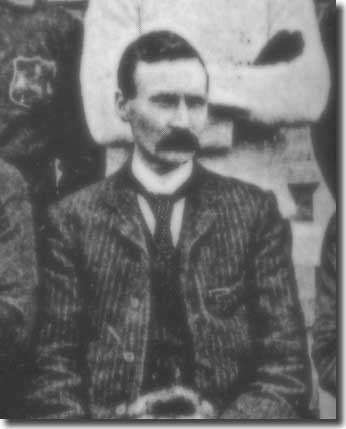 It took a generation for football
to take more than a tenuous grip in the West Riding, but in 1904 Leeds
finally threw up a club that was to enjoy more than a transitory life.
The men behind Leeds City Association Football Club were committed to
making their young organisation a major power and, as they prepared their
bid for election to the Football League in early 1905, they were determined
to recruit an individual who could secure the necessary support from the
League's decision makers. Ideally, they sought someone who already had
experience of League football and could satisfy their longer-term ambitions
for success; they managed to find just such an individual when they appointed
Gilbert Gillies as the club's first manager.
It took a generation for football
to take more than a tenuous grip in the West Riding, but in 1904 Leeds
finally threw up a club that was to enjoy more than a transitory life.
The men behind Leeds City Association Football Club were committed to
making their young organisation a major power and, as they prepared their
bid for election to the Football League in early 1905, they were determined
to recruit an individual who could secure the necessary support from the
League's decision makers. Ideally, they sought someone who already had
experience of League football and could satisfy their longer-term ambitions
for success; they managed to find just such an individual when they appointed
Gilbert Gillies as the club's first manager.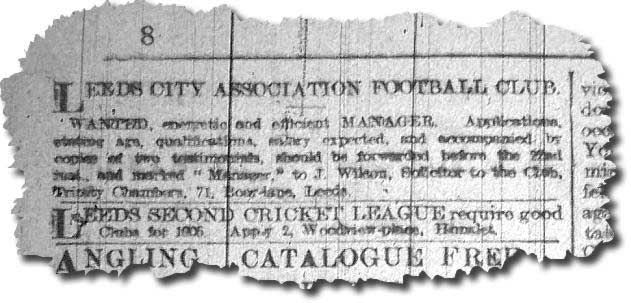 Blackpool
and Darwen.
Blackpool
and Darwen.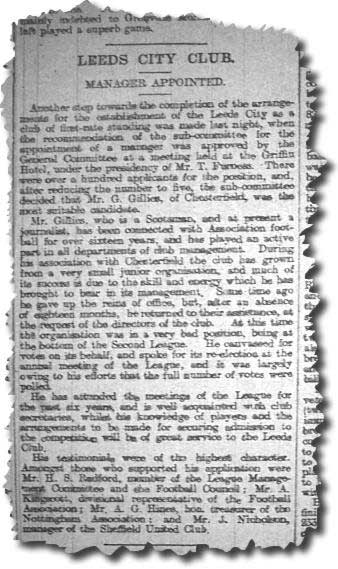 Mr
J Nicholson, manager of the Sheffield United Club.'
Mr
J Nicholson, manager of the Sheffield United Club.'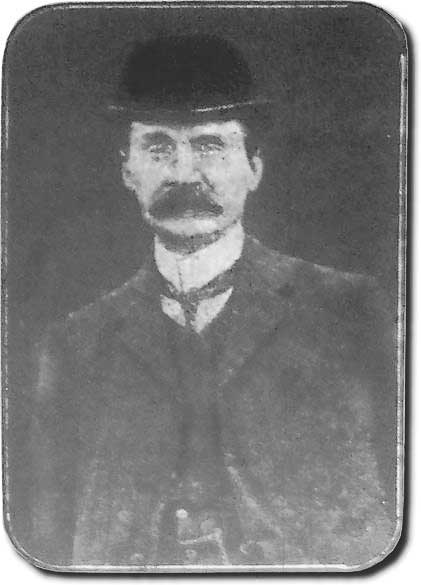 since
he found himself on the wrong end of the fork.
since
he found himself on the wrong end of the fork.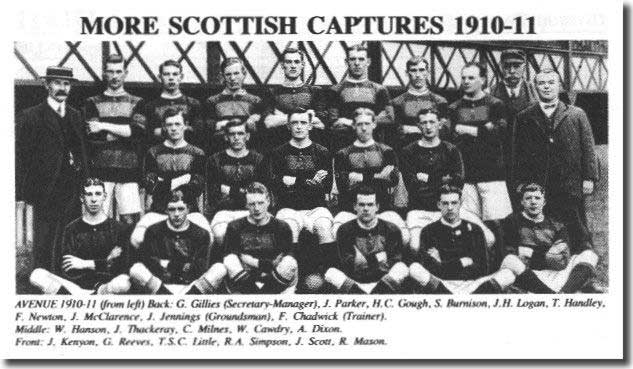 League
were the same day, 27th May. Bradford resigned from the Southern League
and the other two clubs were expelled. Fortunately the Football League
accepted Bradford into the Second Division while QPR withdrew at the last
minute and were accepted back into the Southern set-up but made to play
most of their games midweek. Spurs were rejected by the Football League
and remained in limbo until mid June when Stoke had second thoughts about
Division Two and resigned.'
League
were the same day, 27th May. Bradford resigned from the Southern League
and the other two clubs were expelled. Fortunately the Football League
accepted Bradford into the Second Division while QPR withdrew at the last
minute and were accepted back into the Southern set-up but made to play
most of their games midweek. Spurs were rejected by the Football League
and remained in limbo until mid June when Stoke had second thoughts about
Division Two and resigned.'